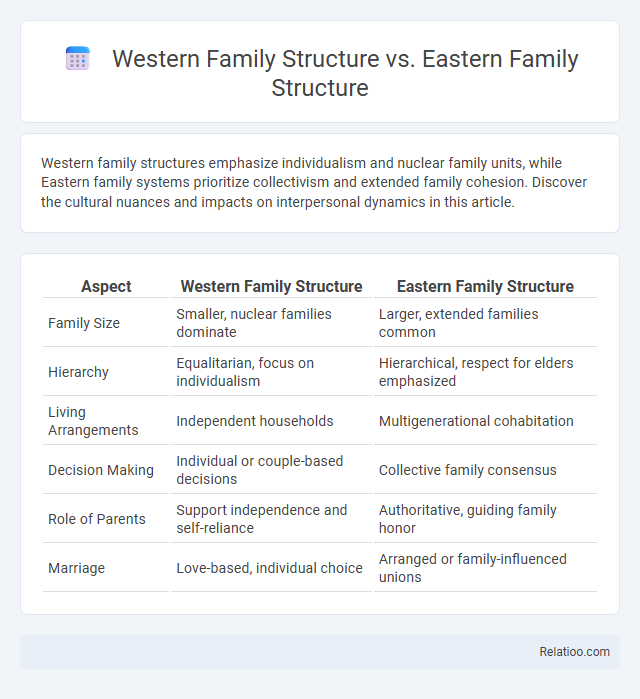Western family structures emphasize individualism and nuclear family units, while Eastern family systems prioritize collectivism and extended family cohesion. Discover the cultural nuances and impacts on interpersonal dynamics in this article.
Table of Comparison
| Aspect | Western Family Structure | Eastern Family Structure |
|---|---|---|
| Family Size | Smaller, nuclear families dominate | Larger, extended families common |
| Hierarchy | Equalitarian, focus on individualism | Hierarchical, respect for elders emphasized |
| Living Arrangements | Independent households | Multigenerational cohabitation |
| Decision Making | Individual or couple-based decisions | Collective family consensus |
| Role of Parents | Support independence and self-reliance | Authoritative, guiding family honor |
| Marriage | Love-based, individual choice | Arranged or family-influenced unions |
Defining Western and Eastern Family Structures
Western family structures often emphasize nuclear units consisting of parents and children, promoting individualism and personal independence. Eastern family structures typically involve extended families living together or nearby, valuing collectivism, respect for elders, and strong intergenerational bonds. Understanding these distinctions helps you appreciate the cultural foundations that shape family roles and dynamics across different societies.
Historical Evolution of Family Systems
Western family structures historically emphasize nuclear units, evolving from agrarian societies to industrialized economies prioritizing individualism and mobility, while Eastern family systems traditionally maintain extended kinship networks rooted in Confucian values and collective responsibility. The transition in Western societies led to smaller, more autonomous households, contrasting with Eastern families' multigenerational co-residence and hierarchical roles. Both systems reflect adaptations to socio-economic changes, with Western models shifting towards egalitarian roles and Eastern models preserving ancestral lineage and communal support.
Core Values: Individualism vs Collectivism
Western family structure emphasizes individualism, prioritizing personal autonomy, self-expression, and independence within family roles. Eastern family structure centers on collectivism, valuing interdependence, family loyalty, and harmony across generations. Core values in Western cultures promote individual rights and personal goals, whereas Eastern cultures focus on group cohesion and family obligations.
Parental Roles and Authority
Western family structures often emphasize egalitarian parental roles, promoting shared decision-making and nurturing alongside discipline, whereas Eastern family structures typically feature hierarchical authority with clear distinctions between parental and child roles rooted in Confucian values. In Western families, parental authority is frequently balanced with children's autonomy, fostering open communication and individual expression, while Eastern families prioritize respect, obedience, and collective harmony within the authority framework. These differing parental roles and authority dynamics reflect broader cultural values influencing family interactions, child-rearing practices, and social expectations across both regions.
Extended Family: Inclusion and Influence
Extended family plays a pivotal role in Eastern family structures, emphasizing collective decision-making, shared responsibilities, and multigenerational living that strengthens familial bonds and social support systems. In contrast, Western family structures often prioritize nuclear families, where independence and individualism are more pronounced, though extended relatives may still influence important life events and provide occasional support. Your understanding of these differences highlights how cultural values shape the inclusion and influence of extended family members in daily life and long-term family dynamics.
Marriage and Relationship Dynamics
Western family structures often emphasize nuclear families with marriage based on romantic love and individual choice, promoting egalitarian relationships between spouses. Eastern family systems tend to prioritize extended family involvement, arranged marriages, and hierarchical roles that reinforce familial duty and collective harmony. Your understanding of these contrasting dynamics can enhance cross-cultural relationship management and communication within diverse family settings.
Generational Gaps and Communication Styles
Western family structures prioritize nuclear family units emphasizing individualism, often leading to open but less frequent generational communication, while Eastern family structures typically encompass extended families valuing collectivism, resulting in hierarchical communication and closer intergenerational bonds. Generational gaps in Western families are characterized by autonomy and personal choice, causing occasional communication barriers, whereas Eastern families maintain respect for elders and tradition, fostering indirect communication styles to preserve harmony. Understanding these cultural nuances in family dynamics is crucial for addressing intergenerational conflicts and improving cross-cultural communication strategies.
Gender Roles and Expectations
Western family structures often emphasize egalitarian gender roles, promoting shared responsibilities between men and women in both domestic and professional spheres. In contrast, Eastern family structures typically adhere to traditional, patriarchal expectations where men are viewed as primary breadwinners and women as caretakers, reinforcing distinct gender norms. Family structure influences vary globally, with gender roles deeply embedded in cultural, social, and economic contexts impacting expectations for behavior, decision-making, and caregiving.
Influence of Religion and Tradition
Western family structure often emphasizes individualism, shaped by Judeo-Christian values that promote nuclear family units and personal autonomy. Eastern family structure tends to prioritize collectivism, deeply influenced by Confucianism, Hinduism, Buddhism, and Islam, which stress extended family roles, filial piety, and hierarchical respect. Your understanding of family dynamics will differ greatly depending on how religion and tradition shape expectations around authority, duty, and social cohesion within each cultural context.
Impact of Modernization and Globalization
Western family structures often emphasize nuclear households with independent living arrangements, shaped by modernization's focus on individualism and economic mobility. Eastern family structures typically maintain extended family systems, where collectivism and filial piety remain strong despite globalization introducing more nuclear family elements. Your understanding of family structure must consider how modernization and globalization converge to blur traditional boundaries, fostering hybrid family models across cultures.

Infographic: Western Family Structure vs Eastern Family Structure
 relatioo.com
relatioo.com